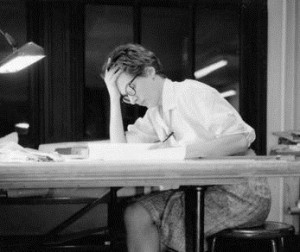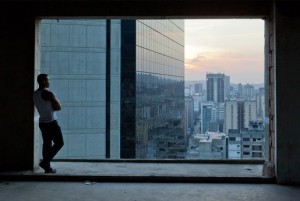By Yun-hua Chen.
DOKU.ARTS, after its seven-year residence in Amsterdam and Brazil, returned to Berlin and has stayed here since 2012. The event focuses on documentaries exploring art and artists, some of which, such as Saving Mes Aynak and The Chinese Mayor this year, follow the project in a longitudinal manner. What is unique about this film festival is their approach to let films unfold with time and in time; this is increasingly difficult within the fast-paced media landscape. In fact, it is as much about art, cinema, human history and social changes as the process of art creation and experimentation. Presenting films which can rarely be seen otherwise and elsewhere, DOKU.ARTS advances the discussion of documentary filmmaking and hosts a feast of essayist, observational, compilation, and biographical films. The film festival is accompanied by a symposium on Architectures in Motion, where William Uricchio, Thomas Elsaesser, and Stan Neumann present, among others, presented their papers and projects. Phyllis Lambert also stepped out of the film Citizen Lambert: Joan of Architecture and graced the festival with her presentation.
Citizen-Lambert: Joan of Architecture, one of the several heart-warming portraits in this edition, pays tribute to this 88-year-old Canadian architect who was awarded with a Golden Lion at last year’s Venice Architecture Biennale. Director Teri Wehn-Damisch traces back to Lambert’s upbringing in a wealthy and socially conservative family, and her subsequent diversion from that life through a devotion to the study of architecture. From New York City’s Seagram tower to the conservation of old mansions and collections of architectural drawings, Phyllis Lambert is portrayed in full complexity – not only as an architect but as a human being questing after art, truth, love, and identity. Astrid by Kristina Lindström is another homage to an iconic woman. The life of the legendary children’s writer Astrid Lindgren, brought to life through abundant use of archival footage, reflects societal change in Sweden over the century. Her separation from her first child stamped her artistic work, life-long social concerns, and involvement in children’s rights in Sweden. Petra Lataster-Czisch and Peter Lataster’s The Need to Dance turn their gaze towards the Flemish-Moroccan choreographer Sidi Larbi Cherkaoui, whose dance choreography can be seen as an outward manifestation of profound inner workings of identity-construction.
Zhou Hao’s The Chinese Mayor is an unusual fit in terms of its ambiguity and geopolitical context, and a rarely seen insider look into the world of a mayor in China. Geng Yanbo, the mayor of Datong City, attempts to restore the desolate mining town to its historical glory dating back to the Ming Dynasty. He embarks upon multi-billion dollar projects of construction, including that of a pseudo-historical city wall, hoping to boost historical tourism and improve the city’s image. With Geng’s approval and trust, possibly out of Geng’s media-consciousness, Zhou Hao gets close to the decision-makers’ circle and even gainsa glimpse of Geng’s family life. While Geng deals with subordinates and construction project managers with an authoritarian tone and a lot of rigor, he is much more soft-spoken with petitioners and his worrying wife. By juxtaposing between filming Geng’s daily tasks and conducting interviews with city-dwellers in public parks and their about-to-be-demolished homes, there is an exceptional, though unspoken, balance between the empowered and disempowered, and the central and the peripheral – a microcosm of the contemporary Chinese society.
In Brent E. Huffman’s Saving Mes Aynak, a group of architects fight against time to rescue the ruins of a millenia-old Buddhist monastery complex in southeastern Afghanistan, before Chinese mining conglomerate MCC starts digging for mineral resources. Threatened by the Taliban, pressured by time, and struggling with political corruption, local archaeologists demonstrate admiring courage and strength to preserve their cultural heritage; their faces are filmed in parallel to the Buddha sculptures they discover. This crossroad for ancient civilisation, between China, India, and Afghanistan, is then sadly transformed into an intersection for profits only.
Markus Kneer and Daniel M. Schwartz’s Torre David documents the eponymous 45-story skyscraper in Caracas. After the project was put on an indefinite hold due to the untimely death of the developer and the collapse of the Venezuelan economy in 1994, it was left idle for over a decade and then transformed into the highest slum in the world through a grassroots movement, with 750 families collaborating in obtaining essentials such as water and electricity and forming a democratic committee. Featuring an improvised rooftop fitness centre assembled with discarded metal wheels, a self-regulated security system, and an on-site grocery shop, their organic vertical community successfully complements where the state social system fails. The documentary might not be all-encompassing in terms of its scope and materials, but Schwartz’s interviews with the local dwellers, in the comfort of their habitat with a breath-taking view, and front-on close-ups very authentically voice out a challenge to both capitalist and slum ways of living.
On the other side of the planet and under a contrasting socioeconomic environment, Ecole Polytechnique Fédérale de Lausanne commissioned the Japanese firm SANAA to build a new learning centre between 2007 and 2010. In Le paysage intérieur, Pierre Maillard documents this ambitious project with its wave-like design from its inception to inauguration, all excitement, doubts and crises included, mostly through the eyes of a young architect Yumiko Yamada. Finally, in Antwerp Central Peter Krüger interweaves fantasy and reality, and past and future, into a dreamy reimagining of a train station. It zooms into details of the station’s ornaments, opens up spaces which are normally hidden from public eyes, and digs in its colonial past in history. Images of the station devoid of passengers are eerie yet poetic, and the narrative labyrinthine and challenging.
Yun-hua Chen is an independent film scholar who contributes regularly to Film International, Exberliner, the website of Goethe Institut, as well as other academic journals. Her monograph on mosaic space and mosaic auteurs is funded by Geschwister Boehringer Ingelheim Stiftung für Geisteswissenschaften to be published by Neofelis Verlag by early 2016.



